Related Research Articles
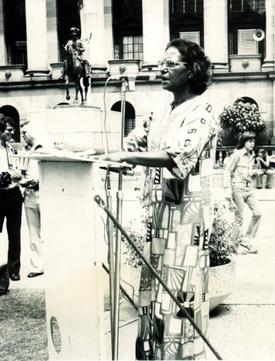
Oodgeroo Noonuccal ( UUD-gə-roo NOO-nə-kəl; born Kathleen Jean Mary Ruska, later Kath Walker was an Aboriginal Australian political activist, artist and educator, who campaigned for Aboriginal rights. Noonuccal was best known for her poetry, and was the first Aboriginal Australian to publish a book of verse.

Roberta "Bobbi" Sykes was an Australian poet and author. She was a lifelong campaigner for Indigenous land rights, as well as human rights and women's rights.
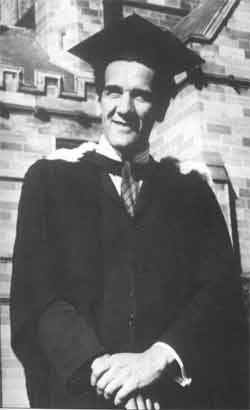
Charles Nelson Perkins, usually known as Charlie Perkins, was an Aboriginal Australian activist, soccer player and administrator. It is claimed he was the first known Indigenous Australian man to graduate tertiary education. He is known for his instigation and organisation of the 1965 Freedom Ride and his key role in advocating for a "yes" vote in the 1967 Aboriginals referendum. He had a long career as a public servant.
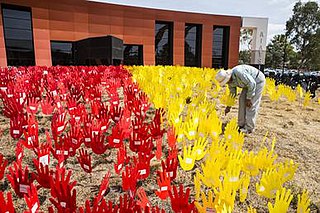
The Australian Institute of Aboriginal and Torres Strait Islander Studies (AIATSIS), established as the Australian Institute of Aboriginal Studies (AIAS) in 1964, is an independent Australian Government statutory authority. It is a collecting, publishing, and research institute and is considered to be Australia's premier resource for information about the cultures and societies of Aboriginal and Torres Strait Islander peoples.
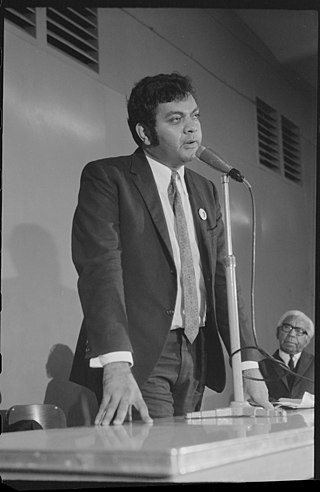
John Newfong was an Aboriginal Australian journalist and writer. A descendant of the Ngugi people of Moreton Bay, he was the first Aboriginal person to be employed as a journalist in the mainstream print media in Australia.

Creative Australia, formerly known as the Australia Council for the Arts and the Australia Council, is the country's official arts council, serving as an arts funding and advisory body for the Government of Australia.

Marcia Lynne Langton is an Aboriginal Australian writer and academic. As of 2022 she is the Redmond Barry Distinguished Professor at the Melbourne School of Population and Global Health, University of Melbourne. Langton is known for her activism in the Indigenous rights arena.
John Kundereri "Jumbana" Moriarty is an Aboriginal Australian artist, government advisor and former soccer player. He is also known as founder of the Balarinji Design Studio, for painting two Qantas jets with Aboriginal motifs.

The Koori Mail is an Australian newspaper written and owned by Indigenous Australians since 1991. It is published fortnightly in printed form and electronic copies are available. Owned by five community-based Aboriginal organisations based in Lismore, in northern New South Wales, its profits are spent on community projects and needs. "Koori" is a demonym for the Aboriginal peoples of parts of New South Wales and Victoria.
Kevin John Gilbert was an Aboriginal Australian author, activist, artist, poet, playwright and printmaker. A Wiradjuri man, Gilbert was born on the banks of the Lachlan River in New South Wales. Gilbert was the first Aboriginal playwright and printmaker. He was an active human rights defender and was involved in the establishment of the Aboriginal Tent Embassy in 1972 as well as various protests to advocate for Aboriginal Australian sovereignty.

The Encyclopaedia of Aboriginal Australia: Aboriginal and Torres Strait Islander history, society and culture, edited by David Horton, is an encyclopaedia published by the Aboriginal Studies Press at the Australian Institute of Aboriginal and Torres Strait Islander Studies (AIATSIS) in 1994 and available in two volumes or on CD-ROM covering all aspects of Indigenous Australians lives and world. There are 2000 entries and 1000 photographs, with the CD-ROM having 250 sound items and 40 videos.
Brian Gregory Syron was an actor, teacher, Aboriginal rights activist, stage director and Australia's first Indigenous feature film director, who has also been recognised as the first First Nations feature film director. After studying in New York City under Stella Adler, he returned to Australia and was a co-founder of the Australian National Playwrights Conference, the Eora Centre, the National Black Playwrights Conference, and the Aboriginal National Theatre Trust. He worked on several television productions and was appointed head of the ABC's new Aboriginal unit in 1988.
The Australian Heritage Commission (AHC), was the Australian federal government authority established in 1975 by the Australian Heritage Commission Act 1975 as the first body to manage natural and cultural heritage in Australia until its demise in 2004. It was responsible for the creation of the Register of the National Estate.

Rachel Perkins is an Indigenous Australian film and television director, producer, and screenwriter. She founded and was co-director of the independent film production company Blackfella Films from 1992 until 2022. Perkins and the company were responsible for producing First Australians (2008), an award-winning documentary series that remains the highest-selling educational title in Australia, and which Perkins regards as her most important work. She directed the films Radiance (1998), One Night the Moon (2001), Bran Nue Dae (2009), the courtroom drama telemovie Mabo (2012), and Jasper Jones (2017). The acclaimed television drama series Redfern Now was made by Blackfella Films, and Perkins directed two episodes as well as the feature-length conclusion to the series, Promise Me (2015).
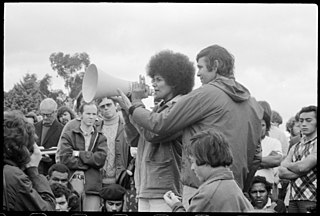
Gordon Briscoe AO was an Aboriginal Australian academic and activist. In 1997, he was awarded a PhD from the Australian National University. He was also a soccer player.
George Cyril Abdullah was an Aboriginal community leader who promoted Indigenous rights by participating in a number of organisations and committees in Perth, Western Australia.
The Aboriginal and Islander Sports Hall of Fame was established in 1994 to recognise Indigenous Australians that have achieved at the highest level of their chosen sport. It was a joint project of the Aboriginal and Torres Strait Islander Commission (ATSIC) and Macquarie University, under the management of Colin Tatz. Inductees are sometimes referred to as "Black Diamonds", being the name of the first book of the project, published in 1996.
Australian Indigenous Ministries, formerly Aborigines Inland Mission of Australia, is an interdenominational Christian organisation that provides ministries to Aboriginal Australians. Aborigines Inland Mission of Australia was established in 1905, and ran many Aboriginal missions across Australia, including the Retta Dixon Home in Darwin, Northern Territory, St Clair Mission in Singleton, New South Wales.
Dawn was an Australian magazine created by the New South Wales Aborigines Welfare Board and aimed at Aboriginal Australians. It ran monthly from January 1952 until December 1968. Two issues were published in 1969, before the disbanding of the Aboriginal Welfare Board led to the publication ceasing.
References
- 1 2 3 4 5 6 7 8 9 10 11 12 13 14 "Records of the Aboriginal Publications Foundation: MS3781" (PDF). AIATSIS Library. Retrieved 29 September 2022.
- ↑ Best, Ysola (1 January 2007). "Donald (Don) Brady". Australian Dictionary of Biography . Retrieved 29 September 2022.
- ↑ Raftery, Judith. "Hampton, Kenneth Valentine (Ken) (1935–1987)". Australian Dictionary of Biography . Retrieved 29 September 2022– via Indigenous Australia.
- ↑ "Harry Nelson Jakamarra". AustLit . 4 June 2021. Retrieved 29 September 2022.
- ↑ "Farewell to a land rights champion of the first order". Central Land Council . 2 March 2021. Retrieved 29 September 2022.
- ↑ Kovacic, Leonarda; Lemon, Barbara (12 February 2019). "Buchanan, Cheryl (1955– )". The Australian Women's Register . First created 27 July 2005. Retrieved 1 October 2022.
- ↑ "History". Roberta Sykes Indigenous Education Foundation. Retrieved 26 September 2022.
- ↑ Pjanic, Dana (16 November 2020). "Chilly, Sue (1954– )". The Australian Women's Register . Retrieved 1 October 2022.
- 1 2 3 "Identity". AIATSIS . Retrieved 30 September 2022.
- ↑ "Identity [catalogue entry]". National Library of Australia. ISSN 0311-1148 – via Trove.
- ↑ Aboriginal and Islander identity, Aboriginal Publications Foundation, retrieved 30 September 2022
- ↑ Perkins, Charles (June 1982). "The 1988 Bi-centennial: No cause for celebration". Identity. 4 (7): 30–32.
- ↑ "INFOKOORI". primo-slnsw.hosted.exlibrisgroup.com. SLNSW . Retrieved 30 September 2022.
- ↑ "Identity Magazine - Institution". Reason in Revolt. 23 August 2005. Retrieved 30 September 2022.
- ↑ "Denis Walker", Collaborating for Indigenous Rights 1957–1973, National Museum of Australia, archived from the original on 8 March 2020